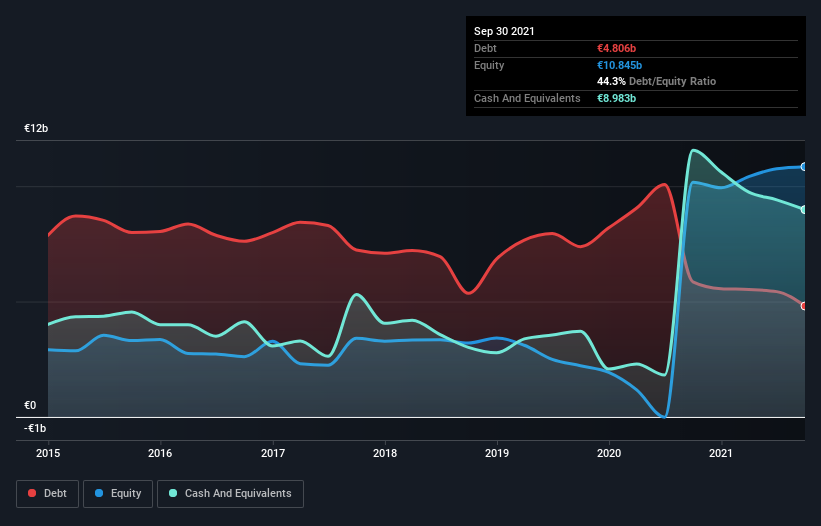Howard Marks put it nicely when he said that, rather than worrying about share price volatility, 'The possibility of permanent loss is the risk I worry about... and every practical investor I know worries about.' So it seems the smart money knows that debt - which is usually involved in bankruptcies - is a very important factor, when you assess how risky a company is. We can see that thyssenkrupp AG (ETR:TKA) does use debt in its business. But should shareholders be worried about its use of debt?
When Is Debt A Problem?
Generally speaking, debt only becomes a real problem when a company can't easily pay it off, either by raising capital or with its own cash flow. In the worst case scenario, a company can go bankrupt if it cannot pay its creditors. However, a more common (but still painful) scenario is that it has to raise new equity capital at a low price, thus permanently diluting shareholders. Having said that, the most common situation is where a company manages its debt reasonably well - and to its own advantage. When we think about a company's use of debt, we first look at cash and debt together.
View our latest analysis for thyssenkrupp
How Much Debt Does thyssenkrupp Carry?
The image below, which you can click on for greater detail, shows that thyssenkrupp had debt of €4.81b at the end of September 2021, a reduction from €5.86b over a year. However, it does have €8.98b in cash offsetting this, leading to net cash of €4.18b.

How Strong Is thyssenkrupp's Balance Sheet?
Zooming in on the latest balance sheet data, we can see that thyssenkrupp had liabilities of €13.3b due within 12 months and liabilities of €12.6b due beyond that. On the other hand, it had cash of €8.98b and €5.87b worth of receivables due within a year. So its liabilities total €11.1b more than the combination of its cash and short-term receivables.
This deficit casts a shadow over the €5.95b company, like a colossus towering over mere mortals. So we'd watch its balance sheet closely, without a doubt. At the end of the day, thyssenkrupp would probably need a major re-capitalization if its creditors were to demand repayment. Given that thyssenkrupp has more cash than debt, we're pretty confident it can handle its debt, despite the fact that it has a lot of liabilities in total.
We also note that thyssenkrupp improved its EBIT from a last year's loss to a positive €321m. The balance sheet is clearly the area to focus on when you are analysing debt. But it is future earnings, more than anything, that will determine thyssenkrupp's ability to maintain a healthy balance sheet going forward. So if you want to see what the professionals think, you might find this free report on analyst profit forecasts to be interesting.
Finally, a business needs free cash flow to pay off debt; accounting profits just don't cut it. While thyssenkrupp has net cash on its balance sheet, it's still worth taking a look at its ability to convert earnings before interest and tax (EBIT) to free cash flow, to help us understand how quickly it is building (or eroding) that cash balance. Over the last year, thyssenkrupp saw substantial negative free cash flow, in total. While that may be a result of expenditure for growth, it does make the debt far more risky.
Summing up
While thyssenkrupp does have more liabilities than liquid assets, it also has net cash of €4.18b. However, we do find both thyssenkrupp's level of total liabilities and its conversion of EBIT to free cash flow troubling. So despite the cash, we do think it carries some risks. Even though thyssenkrupp lost money on the bottom line, its positive EBIT suggests the business itself has potential. So you might want to check out how earnings have been trending over the last few years.
If, after all that, you're more interested in a fast growing company with a rock-solid balance sheet, then check out our list of net cash growth stocks without delay.
New: Manage All Your Stock Portfolios in One Place
We've created the ultimate portfolio companion for stock investors, and it's free.
• Connect an unlimited number of Portfolios and see your total in one currency
• Be alerted to new Warning Signs or Risks via email or mobile
• Track the Fair Value of your stocks
Have feedback on this article? Concerned about the content? Get in touch with us directly. Alternatively, email editorial-team (at) simplywallst.com.
This article by Simply Wall St is general in nature. We provide commentary based on historical data and analyst forecasts only using an unbiased methodology and our articles are not intended to be financial advice. It does not constitute a recommendation to buy or sell any stock, and does not take account of your objectives, or your financial situation. We aim to bring you long-term focused analysis driven by fundamental data. Note that our analysis may not factor in the latest price-sensitive company announcements or qualitative material. Simply Wall St has no position in any stocks mentioned.
About XTRA:TKA
thyssenkrupp
Operates as an industrial and technology company in Germany and internationally.
Excellent balance sheet and fair value.
Similar Companies
Market Insights
Community Narratives



